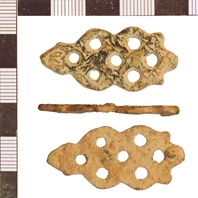
Viking Objects
Anglo-Scandinavian Mount (NLM-491EBD)
This copper-alloy mount is decorated with an openwork plate interlace ornamentation in possible Borre style.
Read More
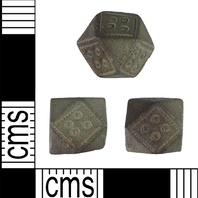
Viking Objects
Polyhedral Weight (LIN-752A9C)
This copper-alloy weight is of a type common within the Scandinavian diaspora. This example has fourteen sides and four dots on each of the rectangular sides. These weights were adopted by the Vikings from Middle Eastern examples and appear to have become a de facto weight standard for traders. Weights are an important form of evidence for Viking Age commerce and the use of standards across the different economic systems within which Vikings were integrated. Many of the weights discovered, particularly ones in Ireland and those of Arabic type, suggest that a standardized system of weights existed in some areas. These standard weights, alongside standard values of silver, are what allowed the bullion economy of Viking occupied areas to function. A bullion economy was a barter economy that relied on the exchange of set amounts of precious metal in various forms, such as arm-rings or coins, for tradable goods, such as food or textiles. Each merchant would have brought their own set of weights and scales to a transaction to make sure that the trade was conducted fairly.
Read More
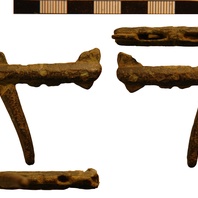
Viking Objects
Folding Arm Pivot Fragment (NLM-6A2893)
Scales were a common commerical tool and would have been an important part of any exchange whether using a monetary system or a bullion system, such as the one that existed in Viking-occupied areas of England.
Read More
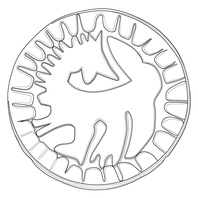
Viking Designs
Drawing of a Brooch with Backwards-Facing Beast
Drawing of a disc brooch found at South Ferriby, Lincolnshire with a backwards-facing beast motif. For more information on Scandinavian jewellery in England check out our blog: Brooches, Pendants and Pins: Scandinavian Dress Accessories in England.
Read More
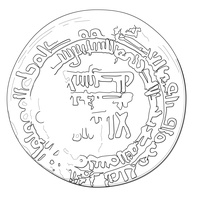
Viking Designs
Drawing of an Arabic Coin
Drawing of an Arabic silver dirham minted in the Middle East and probably brought to Lincolnshire by Viking traders. The dirham was a unit of weight used across North Africa, the Middle East, and Persia, with varying values which also referred to the type of coins used in the Middle East during the Viking Age. These coins were extremely prized possessions not only for their silver value but as a way of displaying one’s wealth and vast trade connections. Millions of Arabic Dirhams would have been imported throughout the Viking world and are mostly found in hoards. Arabic dirhams demonstrate contact between the Viking diaspora and the Arabic world. Arabic coins are especially useful for dating sites, because they carry the date when they were minted. This permits precise dating where the part of the coin with the date survives, whereas European coins can only be dated to the reign of the ruler depicted on them. In western descriptions of these coins, the Arabic dates found on the coins are usually listed in square brackets, as above, and the European equivalent is listed after it.
Read More
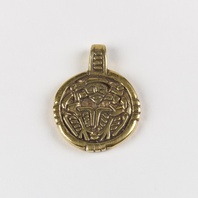
Viking Objects
Reproduction Pendant with an Odin Motif
This reproduction of a cast silver, gilded pendant featuring an image of a one-eyed figure with two birds has been interpreted as Odin and his two ravens, Huginn and Muninn. The original pendant was found at Winteringham, Lincolnshire. There are a number of close parallels which establish the wide currency of this subject group. These include numerous examples from Russia and two from Sweden, including some with silver gilding. A silver pendant with a related, but distinct design is known from Sjælland, Denmark.
Read More
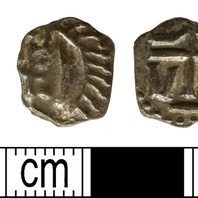
Viking Objects
Merovingian Denier (DENO-4A202A)
This is a silver denier produced by the Merovingian Franks around 700 to 750 at the mint of Marseille. It is possible that it made its way to England prior to Viking incursions but it is equally likely that the Vikings brought this coin with them as plunder after raiding in Frankia.
Read More
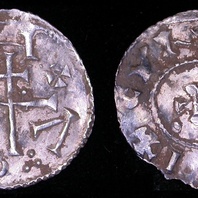
Viking Objects
Viking Silver Penny (LEIC-B230B8)
This silver ‘Cunnetti’ penny comes from the Viking kingdom of York and was minted on the authority of ‘Cnut of Northumbria’. Minting coins was a way of controlling the means of exchange within a kingdom and which created a more easily administered standardized system of trade. Moreover, the coins themselves were often used as propaganda, portraying symbols and statements that gave off a desired message. The Vikings later used the minting of coins to legitimize their own rule.
Read More
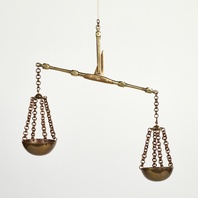
Viking Objects
Reproduction Scales
Scale pan set in copper alloy based on fragments of an arm from Cromwell, Nottinghamshire (DENO 0619F7), a pivot from Northope, Lincolnshire (NLM 6A2893), and a suspension arm and pans based on originals from York and St Peter’s Street, Northampton. Scales were a common commercial tool and would have been an important part of any exchange whether using a monetary system or a bullion system such as the one that existed in Viking-occupied areas of England.
Read More
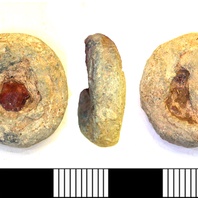
Viking Objects
Circular Weight (LEIC-5C4051)
This circular weight has a centrally placed orange stone chip inlaid into it. The distinction of weights by embedded objects or other embellishments in various media is a widely recognised feature of some early medieval weights. Weights are an important form of evidence for Viking Age commerce and the use of standards across the different economic systems within which Vikings were integrated. Many of the weights discovered, particularly ones in Ireland and those of Arabic type, suggest that a standardized system of weights existed in some areas. These standard weights, alongside standard values of silver, are what allowed the bullion economy of Viking occupied areas to function. A bullion economy was a barter economy that relied on the exchange of set amounts of precious metal in various forms, such as arm-rings or coins, for tradable goods, such as food or textiles. Each merchant would have brought their own set of weights and scales to a transaction to make sure that the trade was conducted fairly.
Read More
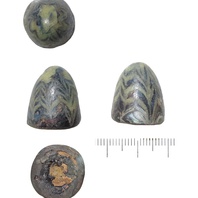
Viking Objects
Glass Gaming Piece (LIN-C31CD7)
There are different possible interpretations of this Lincolnshire find from 2012. It could be a playing-piece as interpreted in the reproductions. Anglo-Saxon playing-pieces of shaped animal tooth are of similar dimensions, while glass counters were used both in the Roman period and taller glass playing men in the Viking period. This find is however considered by some archaeologists more likely to be a decorative setting from fine metalwork. The rather muddy glass colours suggest that the glasses used had already been recycled, and the clay core indicates careful use of a precious resource as well as a means of moulding on a decorated sheet of glass. The best parallels for this find, though none matches the form, are the oval cabochon pieces of dark blue and opaque white glass from the Anglo-Saxon monastery at Monkwearmouth, County Durham. Prominent coloured glass inlays are a part of the Insular tradition with its roots in Ireland. In Irish work the emphasis is on contrasting coloured zones and inlays, technically more complex and in a diverging tradition from this new find, though imitated elsewhere in English work.
